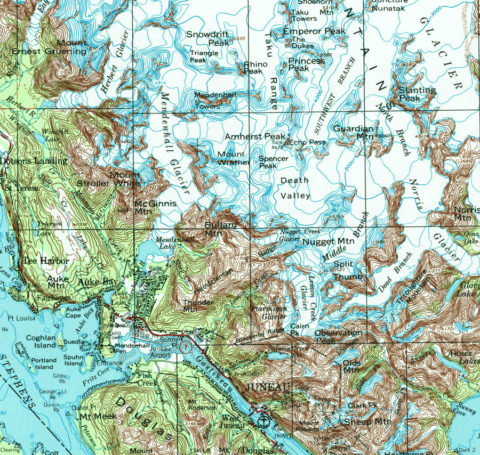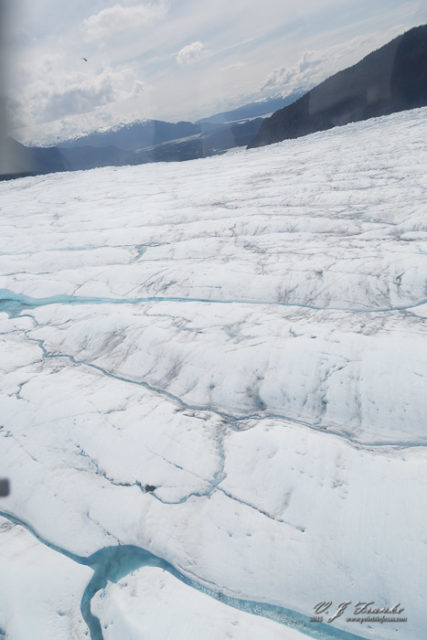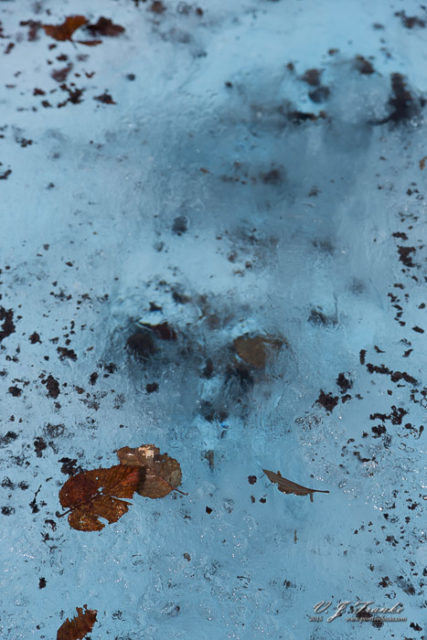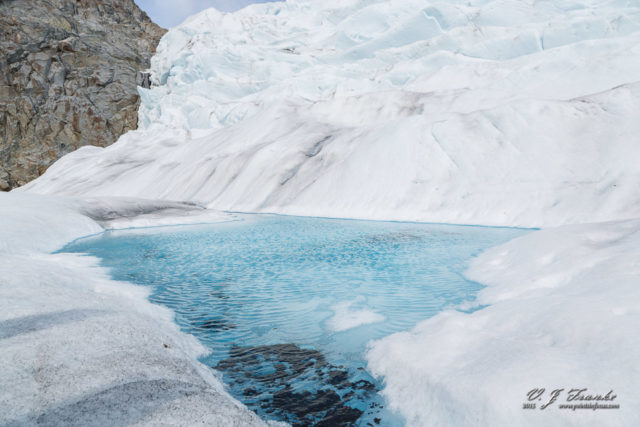Mendenhall Glacier, Juneau, Alaska
Back in May I went on a 9 day cruise to Alaska up the inside passage. Though the cruise was just a regular cruise, I had my camera and that’s good enough for me. Previously, I wrote about my experiences with photography on a floatplane excursion, this time I’m going to talk about a glacier walkabout and the opportunities for photography on a glacier.
Our excursion was operated by NorthStar Trekking of Juneau, AK. As much as I’d like to recommend them—to be honest, the experience was really good—I simply don’t have enough experience with this kind of activity to make any kind of intelligent comment on the matter.
NorthStar offers 3 levels of glacier excursion in increasing difficulty. The excursion I was on was their Helicopter Glacier Walkabout, which takes about 3 hours and offers about 1 hour of time on the glacier. Stepping up from that they offer two more strenuous excursions, the Helicopter Glacier Trek (2 hours of glacier time) and the Extended Helicopter Glacier Trek (3 hours of glacier time).
I should also point out, while our excursion ended up on Mendenhall glacier, there’s no guarantee that yours will too. The operators evaluate the weather and ice conditions to determine which glacier is safest for this kind of excursion to visit. NorthStart notes in their sales material that you may end up visiting any of the following glaciers; Mendenhall, Taku, Norris, Herbert, Gilkey, Battle, or Thiel.

If I had to guess, given equal ice conditions, they probably want to favor Mendenhall since it’s the glacier most people would recognize and want to see—in so far as you can actually see anything while on it. However, I couldn’t say for sure.
In any event, NorthStar, probably like any other operator that caters to the cruise lines, has the procedure down to a science. When we got off the ship we checked in with their representative at the dock and provided our weight and shoe size and waited for the rest of the people to show up.
Your weight is used to balance the helicopter properly, and as an educated guess to get the right size pants and jacket to get ready for you. After we were all checked in, they called ahead to the outfitters office with our info before we even got in the van for the drive over to the airport.
When we arrived at the outfitter, they’d already put together our gear along a pair of benches—I think there were 8 or 9 of us on this particular excursion. For this excursion, we were provided all the gear we “needed”. At their offices we were equipped with the following:
- A pair of two-part mountaineering boots,
- A pair of water proof pants
- A water proof jacket shell,
- A waist pouch/fanny pack/belly bag/whatever you want to call it with a snack bar, bottle of water, and tissues
And when we got to the glacier, we were then provided with crampons and a hiking pole.
At this point, since this is my blog and I can do this, I’m going to go off on a tangent here and have a bit of a whine about gear. Click here to skip this tangent.
To start with I want to be perfectly clear. I understand why NorthStar Trekking does what they do regarding the gear. However, that doesn’t mean I have to shut up and like it. I also want to be perfectly clear, this isn’t a slight at NorthStar Trekking either. They have to operate under certain conditions in terms of safety and efficiency to be able to handle cruise excursions and do so profitably. As far as I know, all the other operators operate in a similar manner as well.
That said, wherever practical and possible, I prefer to own and use my own gear. Experience has taught me that for most things, I can generally get gear something that fits better and has fewer potential problems when I’m shopping. That’s not to say I’ll never use provided gear—buying a pair of crampons for $150 when I live in Florida just does’t make sense.
On the other hand, something like a hardshell waterproof jacket and pants, well I have them. I already had a pair of hardshell waterproof pants, and a waterproof hardshell jacket (it also happened to be “expedition red” because I like the color) that fit me well. Neither were bought specifically for the glacier excursion, and both have proven to be quite handy even in Florida for dealing with rain in the summer and windy mornings in the winter.
Having no experience with this kind of excursion and not having done a whole lot of research into glacier trekking/mountaineering ahead of time, I decided to go with the flow and just take what they gave me. I left my waterproof pants on the boat, and while I asked about not wearing their shell over my jacket, I didn’t push the issue when they said to wear it.
In retrospect there were a number of points where I should have used my own judgement and worn or used my gear or left something at the outfitter’s office instead of going with what they said.
Having 2 jacket shells with identical water and windproof capabilities ended up being rather annoying, though not hugely problematic. Sure it didn’t restrict my range of motion appreciably or cause any obvious safety issues. However it got in the way of my camera a couple of times. Moreover, it was simply redundant, it provided no more protection and no better protection than my jacket.
The pants were a bigger annoyance, in fact, if I recall correctly they were the non-zip version of the Marmot pants I own. Both of these pants are plagued with a simple design defect, they rely entirely on the elastic in the waist to hold them up. Admittedly my pants aren’t much better in this respect, except that they’re newer and the elastic is tighter, and the Precip Zip pants can be tightened slightly using hook-and-loop tabs that hold the waist together. (Incidentally one workaround I’ve since discovered for this is to use binder clips to clip the Precip pants to my belt.)
The waist pack was a much bigger annoyance for me. For “security” reasons, we were prohibited from taking our own bags on the helicopter. I’m not sure I buy the security excuse—but whatever, their helicopters, their excursion, their rules, I’d deal with it.
In any event, the waist bag I had was crap—sadly I didn’t realize that until I was on the glacier and it was being a pain in the rear by not staying tight and falling down. I wasted more time on the glacier readjusting the thing after it came loose and slipped down than was at all desirable.
In hind sight, and this would be my tip, given that the only thing in the waist pack was a snack bar, a pack of tissues, and a bottle of water—all of which will fit in a jacket pocket quite easily—leave the pack and put the stuff in your jacket. At least I should have done that.
Okay tangent over, back to the excursion.
The flight out was in part a sight seeing tour, not a long one mind you, but one that was long enough to see a bit of the area and how glaciers form and work.
We flew out northwest from Juneau’s airport, to what I think was Herbert Glacier, then up the glacier to the Juneau ice field. Truthfully, I’m completely sure what the flight plan was exactly, and it’s hard for me to recreate the flight route from memory.

Moreover, unless you’re a pilot, and perhaps one that has a lot of experience flying in that area, it’s just really hard to tell what is going on. The helicopters we were flying easily cruise at 150MPH, and their service ceiling is 15,000 feet. Doing 150 MPH at 6000 feet or so like we were, and it’s easy to misjudge the size of something—that huge glacier doesn’t look all that big, and it didn’t take very long to fly over it.
I cannot underscore the importance of having decent sunglasses whenever you’re out on not only the glacier but in the helicopter on the flight out. I won’t say I learned this the hard way. I knew what I was getting into when I gave my sun glasses to my dad who left his on the boat. Instead I had to rely on my transitions prescription lenses the entire time. The good news was that they provided acceptable performance once we got out on the glacier. However, in the air they were utterly useless and the flight out was painfully bright.
For those that don’t know, photo-chromatic lenses, like mine, use UV light hitting the lenses to darken them. The dye reacts with the UV light to become dark, and fades when the UV source is removed. It works well when you’re outside, but glass, or plexiglass, blocks enough UV to render them nearly useless inside a car or helicopter.
Once we landed on the glacier, we made our way to the outfitter’s basecamp to get our crampons on. And then on to the glacier experience.
As I said, I was on the non-strenuous walkabout. Even though we were on the glacier and walking around for about an hour, we never had to deal with anything real technical or physically challenging. Yes, there were some hills to walk up, but they weren’t much more challenging than a hill in the middle of a park’s field.
At this point, I’d be remiss if I didn’t talk some about the photographic opportunities. Sure from afar glaciers are mostly just a big blob with some cracks and wrinkles. However up close there are a number of interesting elements that can make for interesting images.
For starters, the surface of the ice has some counter intuitive properties. Anything that isn’t basically white will melt into the surface, due to the heat absorbs. Since there are trees on some of the ridges surrounding the area on Mendenhall glacier where we were, there were loads of leaves frozen some inches below the surface. The following image is a poor example of the kind of abstract imagery that you can shoot on a macro level.

In addition to leaves, as the glaciers move over terrain, or due to avalanches or rock slides, the glacier will collect and pulverize rocks. In many places you’ll see what look like rocks at or near the surface, that will turn out to be extremely finely pulverized silt.
Moreover, during the warmer months, the surface of the glacier will melt, and the runoff will collect in low spots creating pools of ice cold glacial water.

These pools may eventually overflow and the resulting stream will erode the ice along it’s path forming small “canyons” in the surface, along with small scale water falls and rapids as the water melts and erodes a channel down hill.
Sadly, I didn’t have the time or opportunity to really photograph one of these, though they certainly would make interesting images. Imagine a miniature slot canyon, with icy blue and white walls.
Of course, there are also large scale structures structures, like crevasses and ice caves, neither of which our introductory walkabout go anywhere near.
Thus I get to gear, and what I found worked best. Some of this of course will be dictated by the excursion. For example, I couldn’t take a camera bag or a tripod even if I wanted to—and there were a couple of cases where I would have liked one, even though it wasn’t super necessary.
Not having the capability to carry a lot of extra gear, flexibility is the name of the game. A wide to mid-telephoto zoom is probably idea. I used my 5D mark III and my EF 24–105mm f/4L IS USM. However, in retrospect, a 18-55 on a APS-C mirror less or one of the high-end (like the Canon Powershot G series) compacts would have been even better.
Unlike the experience I had with the float plane, corner performance wasn’t nearly as much of an issue here. A lot of this comes down to the nature of the subject matter, in that previous trip my corners were filled with branches and leaves, fine details that look obviously worse when they are rendered poorly. On the glacier the corners are generally going to be sky or ice. And while there’s certainly detail in the ice, it’s not nearly as pronounced or easily discernible as branches and leaves are.
That said, the biggest challenge I found in the excursion was simply pacing. An hour is really not a lot of time when you get right down to it. And more of that time was consumed with putting on and taking off our crampons. In fact, I managed to shoot very few images on this excursion simply because I didn’t really have the time to set up and execute them—though there’s plenty of time to take snapshots of friends or family on the glacier with you.
With all that said, I really enjoyed the experience on the glacier and would not only do it again in a heartbeat—even if it wasn’t the best opportunity for the kind of photography I prefer to do—but recommend it to pretty much anybody.
Comments
this article is very useful, thank you for making a good article